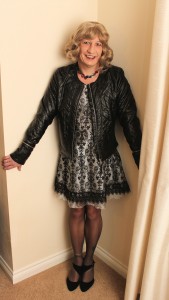Book Review: Men Can Wear Dresses Too
 The author constructs a life story of her trials and tribulations in the realm of crossdressing, transvestism and transgenderism. Portions of her life would rival The Perils of Pauline.
The author constructs a life story of her trials and tribulations in the realm of crossdressing, transvestism and transgenderism. Portions of her life would rival The Perils of Pauline.
Interspersed through the story are summaries of research from several sources. The author’s life story is interrupted from time to time by the research making it difficult to seamlessly transition from story to research and back to story.
The presentation of the research summaries provides an interesting backdrop although it is difficult, if not impossible, to dovetail the research with each section of the story it interrupts.
The depth and breadth of the research is limited, and in some aspects dated. It also appears to be focused exclusively on Great Britain, which raises the question of whether some of the findings are peculiar to the British culture. The author points out the limitations and potential flaws in the research and the findings based on the conclusions of the researchers. There appears to be either a bias to the research, failure of the researchers to secure sufficient funding to develop and implement an exhaustive protocol, or lack of rigor in determining the threshold number of research subjects that would produce fidelity in the research findings.
The author’s story is at times gripping; the reader can sense the anticipation, angst, anxiety and frustration she experiences. At other times the author interjects too much detail, mundane and not particularly relevant to the background or purpose for the book.
Overall the information presented from the research findings may be valuable to the reader. Based on the presentation and the author’s commentary on certain parts of the research, the reader is encouraged to draw their conclusions as to the integrity, fidelity and utility of the information.
From a story standpoint readers will more than likely be able to associate/connect with the author as her life twists, turns and flips from one gender to the other, including the overarching need to disclose crossdressing to each of the women who shared portions of the author’s life.
Men Can Wear Dresses Too
By Catie Maye
Hardcover | 6 x 9 in | 376 pages | ISBN 9781491894262 Softcover | 6 x 9 in | 376 pages | ISBN 9781491894279 E-Book | 376 pages | ISBN 9781491894286
Available at Amazon and Barnes & Noble
Category: Product Review












Thanks Catie for your feedback. As the author you have feelings and insights that may not radiate from the book as clearly and transparently as you would like.
As an author of mostly fiction novels under a pseudonym, I attempt to weave the message throughout the story. Unless I missed something, the conclusion indeed would have been more helpful to have been woven throughout.
As for the surveys, a more clear message as to the geographic limitations (I did not see much if any presented research that was conducted outside Great Britain) – the author’s attempt to gather information from world-wide sources came up with xx number of research data points within yyyy date ranges – would have sent a more powerful message to the reader.
Invisibly Obvious or Obviously Invisible? – Authors Response
Book Review – Men Can Wear Dresses Too by Nikki Nicole
Whilst I am grateful to Nikki Nicole for her constructive review of my book Men Can Wear Dresses Too I feel that the underlying message of the book has remained either invisibly obvious or obviously invisible to her.
Nikki uses the very point of book as it’s main criticism and thereby perhaps misses the most important issues.
Nikki, her review states ‘The depth and breadth of the research is limited, and in some aspects dated’. Yes, Nikki that’s exactly the point! There is very little contemporary research currently being carried out on the subject of cross dressing, with cross dressers themselves. One has to trawl back over the last half a century to find anything meaningful! Contrary to much of the data used in the book her review makes no mention that one of the key surveys covered in the book, is actually current and still running. Furthermore, by using survey data covering a period of many years it is more useful to track trends rather than points in time which may not be representative of an evolutionary or development cycle.
Nikki further asserts ‘There appears to be either a bias to the research, failure of the researchers to secure sufficient funding to develop and implement an exhaustive protocol, or lack of rigour in determining the threshold number of research subjects that would produce fidelity in the research findings.’ Again, Nikki that’s the point which is invisibly obvious or obviously invisible. She herself confirms in the review ‘The author points out the limitations and potential flaws in the research and the findings based on the conclusions of the researchers.’ This is the data that exists and one can only work with what is currently available!
The surveys incorporated in the book were not selected geographically but chosen to attempt to reflect cross dressing trends. The reader is left to draw their own conclusions as to the relevance and accuracy of the data.
Nikki’s impression was that the ‘story is interrupted from time to time by the research making it difficult to seamlessly transition from story to research and back to story’ yet this did not seem to detract too much as Nikki equally states the ‘author’s story is at times gripping’.
The real message of the book is stated in the conclusion. The need to carry out a contemporary global survey of the cross dressing community, now, in 2014, to help in the understanding and acceptance of those men who cross dress, and who are neither invisibly obvious or obviously invisible.